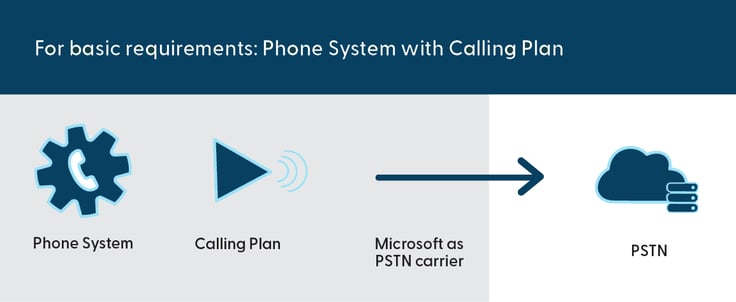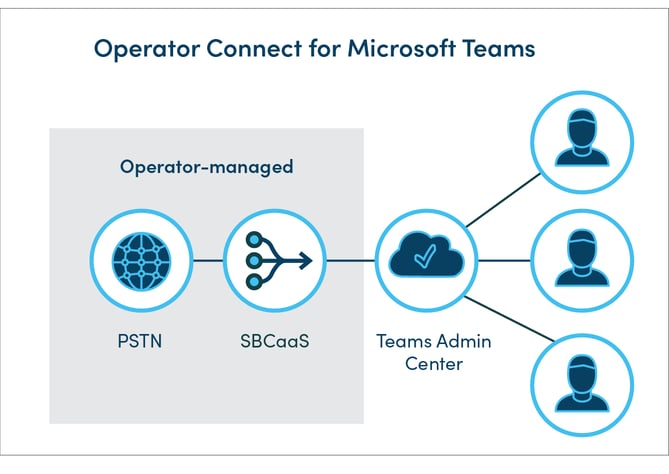If you're looking to enable external calling in Microsoft Teams, you're likely weighing the differences between Microsoft Calling Plans, Operator Connect, and Direct Routing. Each option has its strengths and limitations depending on the needs of your business. This blog will walk through how they work, what makes them different, and when to choose each.
- What are Microsoft Teams Calling Plans?
- What is Operator Connect?
- What is Direct Routing for Teams?
- Operator Connect vs Microsoft Teams Calling Plans vs Direct Routing for Teams
- When to choose Operator Connect vs Microsoft Calling Plans vs Direct Routing
What are Microsoft Teams Calling Plans?
Microsoft Teams Calling Plans are the simplest way to enable PSTN calling within Teams. Microsoft acts as the carrier, providing numbers and a bundle of domestic or international minutes per user.
Each user requires:
-
A Microsoft 365 E5 license (includes Teams Phone Standard), or
-
A Microsoft 365 E1/E3 license with the Teams Phone add-on (typically $8–$10 per user/month)
Pricing varies significantly by region. In the US, Teams Phone with Calling Plan (Domestic) starts at around $15/user/month. Pay-As-You-Go plans are also available in certain countries for low-usage users, but availability is limited.
Calling Plans are managed entirely in the Microsoft Teams Admin Center, and Microsoft controls the telephony infrastructure and routing. This simplicity comes at the cost of flexibility, and geographic coverage is limited to roughly 30–35 countries as of 2025, creating gaps for global deployments.

What is Operator Connect?
Operator Connect offers more flexibility than Calling Plans, without requiring you to run your own telephony infrastructure.

With Operator Connect:
-
Microsoft-certified telecom operators, like Pure IP, provide PSTN calling.
-
You select your carrier in the Teams Admin Center, but all ordering of numbers still happens directly with the carrier—Microsoft does not handle this part.
-
The carrier owns and manages the connectivity.
-
Microsoft uses private network interconnects (“trusted cross-connects”) between its network and the carrier for lower latency and higher call quality.
-
You can manage numbers and assign services directly in the Teams Admin Center, without needing PowerShell for provisioning.
Operator Connect now supports more hybrid integrations than it did in the past, including certain analog device and contact center connections, depending on the carrier.
Costs are typically up to 60% lower than Calling Plans for ongoing service, and coverage depends on the carrier’s PSTN replacement footprint.
Teams Phone Mobile: Available only through certain mobile carriers, this integrates a SIM-based mobile number directly into Teams. For BYOD or extended mobile capabilities outside that program, Pure IP’s Mobile Connect service (powered by Tango Networks) can extend Teams numbers to mobile devices using eSIM.
Related content: Our Ultimate Guide to Operator Connect
What is Direct Routing for Teams?
Direct Routing offers maximum control and flexibility, connecting Microsoft Teams to almost any telecom provider using a certified Session Border Controller (SBC).
You can deploy Direct Routing in two ways:
-
Customer-managed SBC: You operate and maintain the SBC yourself.
-
Managed SBC service: A provider like Pure IP hosts and manages the SBC, giving you the flexibility without the infrastructure overhead.
Direct Routing supports:
-
Integration with on-premises PBXs
-
Analog device connectivity
-
Complex call flows, compliance routing, and call recording
-
Global coverage using your chosen carrier, including regions not supported by Operator Connect or Calling Plans
Many enterprises combine Direct Routing with Operator Connect in a hybrid model for optimal coverage, compliance, and integration flexibility.
Comparison table
| Feature | Microsoft Calling Plans | Operator Connect | Direct Routing |
| PSTN carrier | Microsoft | Microsoft-certified Operator | Any carrier |
| Deployment complexity | Low | Medium | High |
| Setup location | Microsoft Teams Admin Center | Microsoft Teams Admin Center | Teams + SBC (on-prem or hosted) |
| Number porting | Via Microsoft | Via Operator | Via Carrier or Partner |
| SBC required | No | No | Yes |
| Custom Call Routing | Limited to Microsoft defaults | Limited to operator profiles | Fully customizable |
| Legacy PBX/Analog integration | Not supported | Not supported | Supported |
| Countries covered | Limited | Wide (depends on operator) | Global (depends on carrier) |
When to choose each option
Choose Microsoft Calling Plans when:
- Your telephony needs are simple
- You're located in countries supported by Microsoft
- You prefer an all-in-one solution managed by Microsoft
Choose Operator Connect when:
-
You need broader coverage than Calling Plans offer
-
Your preferred carrier is in the Operator Connect program
-
You want cost savings of up to 60% over Calling Plans
-
You need hybrid support for contact centers or certain analog devices without managing an SBC
-
You value cloud-native setup with fast deployment and minimal technical overhead
Choose Direct Routing when:
- You require integration with on-premises PBX or analog devices
- You need global coverage with your chosen telecom provider
- You have complex routing, compliance, or recording needs
- You want full control over call flows and carrier contracts
Think of these options as points on a spectrum. Microsoft Calling Plans are simple but limited. Operator Connect provides more flexibility without requiring deep telephony expertise. Direct Routing gives you full control but comes with more complexity.
Hear from Paul Cornish, Merlin Entertainments about how to deploy Teams Calling globally ⬇️
Can you mix and match Direct Routing and Operator Connect?
Yes, you can mix Direct Routing and Operator Connect within the same Microsoft Teams environment. Microsoft fully supports a hybrid configuration where some users are assigned numbers and connectivity through Operator Connect, while others use Direct Routing.
This hybrid approach can offer the best of both worlds:
- Use Operator Connect for regions where your preferred carrier is certified and can offer a fast, low-touch deployment.
- Use Direct Routing to support locations where no Operator Connect providers are available or to integrate with on-premises systems and legacy infrastructure.
Mixing the two methods also gives businesses more flexibility to meet specific compliance, routing, or cost management needs across different user groups or countries.
This kind of tailored configuration ensures organizations get the right balance of simplicity, control, and global coverage - without being locked into one approach.
Final thoughts
Microsoft Teams offers several options to enable external voice. The best choice depends on your infrastructure, geographic needs, and internal expertise. If you're unsure which path is right, Pure IP can help assess your requirements and deliver a tailored voice solution for Microsoft Teams.
Want to dig deeper? Contact us to speak with a Teams telephony expert.
Pure IP is a Microsoft-certified Operator Connect and Direct Routing provider offering global voice coverage, legacy integration, and managed SBC services.





